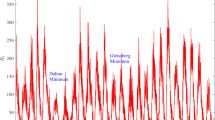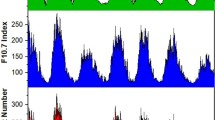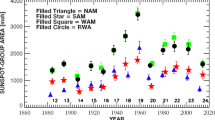Abstract
We study the dynamic evolution of the time series describing the plage regions areas observed daily at the Observatório Astronómico da Universidade de Coimbra, in each one of the solar hemispheres during solar cycles 21 – 23. The classical ARMA model has proven to be insufficient to describe the time variations seen in the data because of the strong conditional variability. We found that the data are well fitted by ARMA mixed with power-δ TGARCH error models. The power index δ is non-integer; this property has recently been introduced in the literature on time-series analyses and indicates the presence of strong volatility and long memory in the data series. We also detected dynamic asymmetry in the plage region areas observed in the two hemispheres when two different temporal models were obtained to fit them. The finding of a dynamic asymmetry is also supported by the dynamic evolution of the daily difference (north–south) time series, which is significantly different from white noise. This statistical modeling of time series, taking into account new and different characteristics of the solar activity, will be very useful in subsequent forecast developments.









Similar content being viewed by others
Notes
This parameter has the same units as the plage region area.
The indicatrix function is defined as \(\mathbb{I}_{A}=\big\{ \begin{array}{l} 1, \text{if } A \text{ happens}, \\ 0, \text{otherwise}. \end{array} \)
The partial autocorrelation of lag k is the correlation between observations X t and X t−k after removing the linear relations among X t−1,…,X t−k+1.
The AR parameter values are estimated by the classical least-squares method, while in the δ-TGARCH parameters the maximum-likelihood estimation is used (Francq and Zakoian 2010).
References
Badalyan, O.G.: 2012, Astron. Lett. 38, 51.
Bankoti, N.S., Joshi, N.C., Pande, S., Pande, B., Pandey, K.: 2010, New Astron. 15, 561.
Bankoti, N.S., Joshi, N.C., Pande, B., Pande, S., Uddin, W., Pandey, K.: 2011, New Astron. 16, 269.
Box, G.E.P., Jenkins, G.M.: 1976, Time Series Analysis: Forecasting and Control, Holden-Day, San Francisco, 285.
Bzowski, M., Mäkinen, T., Kyrölä, E., Summanen, T., Quémerais, E.: 2003, Astron. Astrophys. 408, 1165.
Deng, L.H., Qu, Z.Q., Liu, T., Huang, W.J.: 2013, Adv. Space Res. 51, 87.
Ding, Z., Granger, C.W.J., Engle, R.F.: 1993, J. Empir. Finance 1, 83.
Dorotovič, I., Rybak, J., Garcia, A., Journoud, P.: 2010, In: Dorotovič, I. (ed.) Proceedings of the 20th National Solar Physics Meeting, Slovak Central Observatory, Hurbanovo, 58.
Duchlev, P.I.: 2001, Solar Phys. 199, 211.
Engle, R.F.: 1982, Econometrica 50, 987.
Francq, Ch., Zakoian, J.M.: 2010, GARCH Models, Wiley, Chichester, 93.
Georgieva, K., Kirov, B., Tonev, P., Guineva, V., Atanasov, D.: 2007, Adv. Space Res. 40, 1152.
Gigolashvili, M.Sh., Japaridze, D.R., Mdzinarishvili, T.G.: 2011, Astrophysics 54, 593.
Gonçalves, E., Leite, J., Mendes-Lopes, N.: 2009, Stat. Probab. Lett. 79, 602.
Gonçalves, E., Leite, J., Mendes-Lopes, N.: 2012, Stat. Probab. Lett. 82, 1597.
Gonçalves, E., Mendes-Lopes, N.: 2008, Séries temporais. Modelações lineares e não lineares, Edições Sociedade Portuguesa de Estatística (SPE), Lisbon, 282.
Gonçalves, R., Pinto, A.A., Stollenwerk, N.: 2009, Astrophys. J. 691, 1583.
Gouriéroux, Ch., Monfort, A.: 1990, Series temporelles et modèles dynamiques, Economica, Paris, 63.
Gouriéroux, Ch., Monfort, A.: 1995, Statistics and Econometric Models, Vols. 1 & 2, Cambridge University Press, Cambridge, Vol. 2, 17, 109.
Granger, C.W.J., Ding, Z.: 1995, Ann. écon. Stat. 40, 67.
Haig, J.D.: 2007, Living Rev. Solar Phys. 4(2). http://solarphysics.livingreviews.org/Articles/lrsp-2007-2/ .
Hathaway, D.H.: 2010, Living Rev. Solar Phys. 7(1). http://solarphysics.livingreviews.org/Articles/lrsp-2010-1/ .
Hathaway, D.H., Wilson, R.M., Reichmann, E.J.: 1999, J. Geophys. Res. 104, 22375.
Javaraiah, J.: 2008, Solar Phys. 252, 419.
Knaack, R., Stenflo, J.O., Berdyugina, S.V.: 2004, Astron. Astrophys. 418, L17.
Li, K.J., Wang, J.X., Xiong, S.Y., Liang, H.F., Yun, H.S., Gu, X.M.: 2002, Astron. Astrophys. 383, 648.
Li, K.J., Gao, P.X., Zhan, L.S., Shi, X.J., Zhu, W.W.: 2009, Mon. Not. Roy. Astron. Soc. 394, 231.
Li, K.J., Liu, X.H., Gao, P.X., Zhan, L.S.: 2010, New Astron. 15, 346.
McIntosh, S.W., Leamon, R.J., Gurman, J.B., Olive, J.-P., Cirtain, J.W., Hathaway, D.H., Burkepile, J., Miesch, M., Markel, R.S., Sitongia, L.: 2013, Astrophys. J. 765, 146.
Newcomb, S.: 1901, Astrophys. J. 13, 1.
Newton, H.W., Milsom, A.S.: 1955, Mon. Not. Roy. Astron. Soc. 115, 398.
Noble, P.L., Wheatland, M.S.: 2013, Solar Phys. 282, 565.
Pan, J., Wang, H., Tong, H.: 2008, J. Econom. 142, 352.
Pop, M.-I.: 2012, Solar Phys. 276, 351.
Sen, A.K.: 2009, Adv. Space Res. 44, 1321.
Silverman, B.: 1998, Density Estimation for Statistics and Data Analysis, Chapman & Hall, London, 34.
Sýkora, J., Rybák, J.: 2010, Solar Phys. 261, 321.
Taylor, S.: 1986, J. Econ. Dyn. Control 18, 931.
Temmer, M., Veronig, A., Hanslmeier, A.: 2002, Astron. Astrophys. 390, 707.
Temmer, M., Rybák, J., Bendík, P., Veronig, A., Vogler, F., Otruba, W., Pöotzi, O., Hanslmeier, A.: 2006, Astron. Astrophys. 447, 735.
Vats, H.O., Chandra, S.: 2011, Mon. Not. Roy. Astron. Soc. 413, L29.
Weiss, A.A.: 1984, J. Time Ser. Anal. 5, 129.
Xie, J.-L., Shi, X.-J., Xu, J.-C.: 2012, Res. Astron. Astrophys. 12, 187.
Zhang, J., Woch, J., Solanki, S.K., von Steiger, R.: 2002, Geophys. Res. Lett. 29, 77.
Acknowledgements
We are grateful to the anonymous referee for advice that helped us to significantly improve this article.
Author information
Authors and Affiliations
Corresponding author
Rights and permissions
About this article
Cite this article
Gonçalves, E., Mendes-Lopes, N., Dorotovič, I. et al. North and South Hemispheric Solar Activity for Cycles 21 – 23: Asymmetry and Conditional Volatility of Plage Region Areas. Sol Phys 289, 2283–2296 (2014). https://doi.org/10.1007/s11207-013-0448-8
Received:
Accepted:
Published:
Issue Date:
DOI: https://doi.org/10.1007/s11207-013-0448-8




